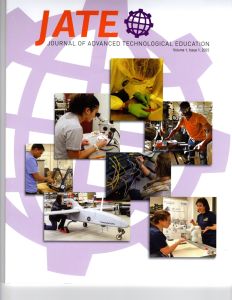
The Journal of Advanced Technological Education (J ATE) began publishing articles online this year and will release its first print edition at the High Impact Technology Exchange Conference later this month.
Creating a high-quality periodical that disseminates peer-reviewed findings about technician education is just one of Peter D. Kazarinoff’s goals as J ATE’s editor-in-chief. He wants the new journal to “build capacity within community college faculty for advancement success.”
Being able to cite “a body of work in peer-reviewed journals is your record of research and your record of success,” Kazarinoff said, pointing out that authoring articles or serving as a reviewer could be a positive factor when educators seek grants, new jobs, or tenure.
An experienced community college faculty member, Kazarinoff notes, “We constantly want to be better at what we do and this is one of the ways that you can be, by publishing in peer-reviewed journals.”
To assist community college educators in this pursuit, J ATE offers professional development through its monthly online meetings for aspiring authors and reviewers. It is also offering a three-day, virtual workshop from September 12 to 15, 2022, that will cover how to write, submit, review, and edit articles for peer-reviewed journals. Stipends are available for qualified faculty.
J ATE Builds Faculty Capacity for Advancement
“We are not just trying to increase J ATE submissions. We are trying to help community college faculty be able to publish in any peer-reviewed journal that they think is applicable,” Kazarinoff explained. He is also a co-principal investigator of the Micro Nano Technology Education Center (MNT-EC) and as a full-time faculty member at Portland Community College in Portland, Oregon, teaches engineering, materials science, and manufacturing courses. MNT-EC’s Advanced Technological Education grant from the National Science Foundation supports J ATE’s electronic and paper editions.

Kazarinoff gained experience in academic publishing while working on his doctorate in materials science and engineering at the University of Washington. There were times in graduate school when preparing academic articles felt like a burden to him. “But it was something that l needed to do, and it was something that was important to do. My research was funded partially through the National Science Foundation, and if the results of that research weren’t shared with the greater scientific community then all that time, effort, and money, what is it good for?”
J ATE Peer Review Process Helps Authors Prepare Manuscripts
That experience motivates him to make J ATE a vehicle for improving technician education and a positive educational experience for aspiring authors.
“It only takes 10 minutes to write a title and have an idea and send it to one of us,” Kazarinoff said referring to himself and the journal’s associate editors.
“We try to help authors to be able to publish their work at whatever stage of readiness they are,” he said.
Kazarinoff considers the informal review of article ideas, abstracts, outlines, and full manuscripts to be a vital aspect of J ATE’s peer-review process.
He has set up many meetings to go over article ideas and has spent considerable time reviewing drafts. Of course, authors must invest time and effort to flesh out ideas to prepare full articles that pass muster with two to three subject-matter experts. But Kazarinoff notes it is a priority of J ATE editors to help authors through the steps of creating a high-quality article that informs technical and community college faculty about innovations and research findings that can be used within specific disciplines or across disciplines.
“If the manuscript is coming from community college faculty and staff who are working in the areas of technician education, we want to work with those authors to build it into something which can eventually be published. That might mean the review process takes longer and there are a bunch of different revisions to be done, but if the idea is good and it is within scope, we work as hard as we can to eventually get that article published,” he said.
J ATE Works toward Sustainability
Although J ATE is in its first year of operation, Kazarinoff and the journal’s editorial board of ATE center principal investigators are planning for a future without NSF funding through MNT-EC.
“I see J ATE as a long-term project, not something that is part of the life of just one center. So next year we’re going to be looking at a bunch of different ways that we can potentially have the journal be self-sustaining, self-supporting,” he said.

 Subscribe
Subscribe


 See More ATE Impacts
See More ATE Impacts

Comments
There are no comments yet for this entry. Please Log In to post one.